So many children are completely entranced by puppets, and they are a fantastic tool to get young people talking and telling stories. Puppets can tell stories themselves, or they can be a part of stories, or they can just inspire children to create tales themselves. The possibilities are immense.
So, how do you use puppets for storytelling? A puppet can introduce a story or show some props. The puppet can be kidnapped by a baddie, or trapped in a hole, or go on holiday. Children can use puppets in their own play to develop narratives and use different voices.
Read on to find out a description of my favorite 14 activities that use puppets for storytelling.
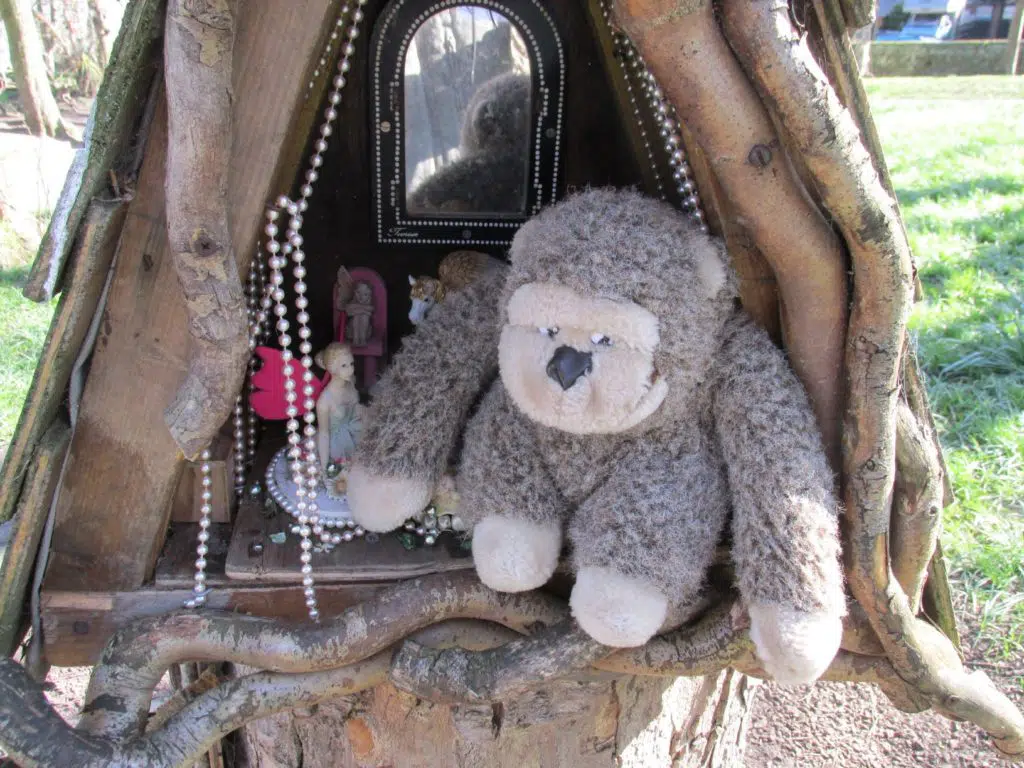
First, Remember To Whisper!
I always try to get the puppet to whisper to me. This is probably not the only way of doing it, but I think it is good for the children to be looking at you. You tell them what the puppet says.
This stops the children from interrupting by saying ‘That’s you speaking’ and other similar things. They normally go along with the pretense if the puppet whispers.
It is also good for them to see your mouth and how the words should be spoken.
Right then. The great fun and puppet activities…
1. Introduce A Puppet In A Wow Way!
Puppets are fantastic if they enter during a moment of drama! For example, you hear a puppet shouting to get released from a box. Or they write a letter that they are stuck in the cupboard.
When you find them in this emotional state, children really want to find out what happened to them. Some will naturally want to help.
Some other great places to find a puppet in need are…
Inside a mystery box! What is inside?
In a cardboard box in one of the learning areas
Up a tree
In a boat on the water tray
Be imaginative! A grand entrance for the puppet will really bring their character to life, and generate that element of awe and wonder that is so precious in the early years.
This is also a puppet show activity I have included in my definitive article about this topic – 22 ways to use puppets in teaching.

2. A Puppet Goes On An Adventure
This is an exciting puppet play activity!
If you have some sort of class puppet, it is sometimes great for them to go missing.
They can leave clues as to where they have gone. A postcard from a puppet, or even a holiday snap really generates great engagement and talk. They could meet all sorts of fascinating characters like dragons and unicorns, and travel to far-off lands.
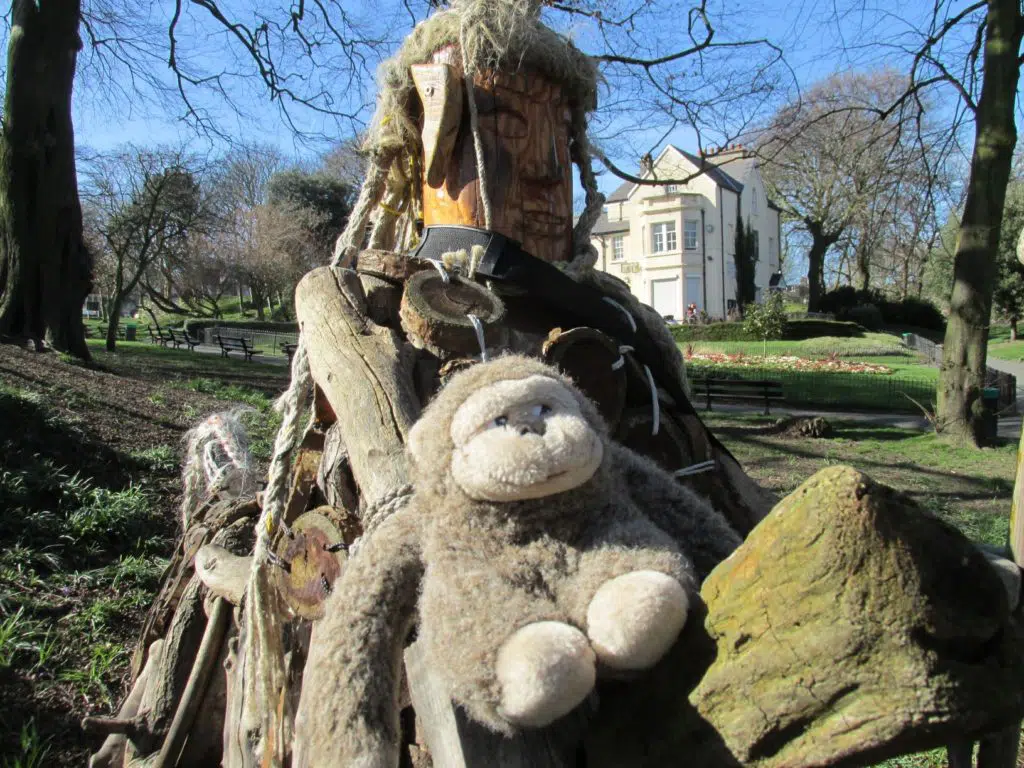
When they get back, they are then ready to unleash the fabulous tale of their adventures.
In their absence, children can recreate their adventures in different areas of learning. Have little mini pictures of the puppet on popsicle sticks to enact what is happening. Or just a photo of the puppet gets them still talking about it.
3. Puppet Uses Story Stones
Story stones are possibly the ultimate storytelling resource, and puppets can really help you out in using them. To find out more about what story stones are, and all the many and varied ways you can use them then check this complete guide.
A puppet can take a stone out of the box and then the children can try to talk about what is happening.
Or the children can give the stones to the puppet, and tell the story to the puppet as they go. Puppets make great listeners.
A puppet can be the star of a story stones story. All you need is one stone that represents the puppet. Then they can get fully involved, and become immersed in the storytelling world. Children will feel a greater sense of empathy in the story with the puppet that they have come to know well.
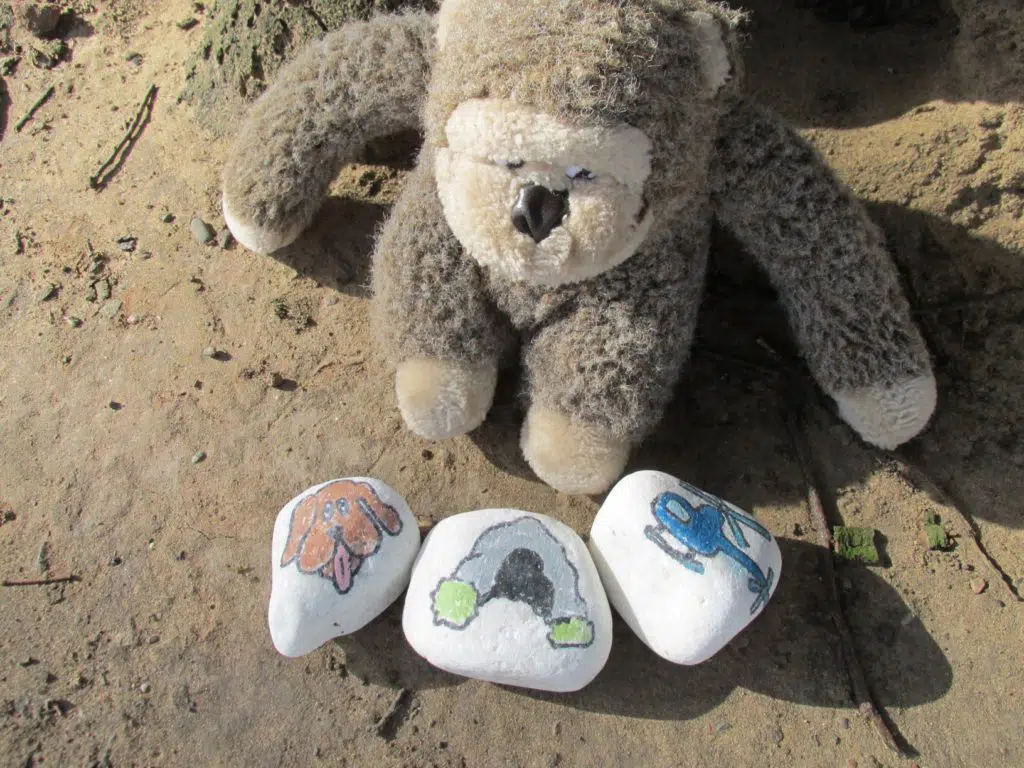
4. Puppet Is Trapped!
Shock, horror! The puppet sends a message that he is trapped somewhere. He gives clues so the children can find him.
He could phone up. This is one of the easiest ways of doing it. Or he could send a treasure map. Or a set of clues.
Either way, try to find the puppet and then get to the bottom of what’s happened and what we can do next.
Great provocation ideas include:
He is chained or taped up by an evil baddy, such as the Big Bad Wolf or the Evil Pea
He is hidden in a cupboard somewhere. Follow the secret clues to find him.
Follow the treasure map that you dig up somewhere outside.
5. Read A Puppet A Story
Sometimes such a simple idea as putting a puppet into your book area can really work wonders. Many children really enjoy reading to a puppet, or they like talking to them about books.
It doesn’t just have to be in a book area. Often verbal storytelling takes place in many locations, such as in dens, or in enclosed comfortable spaces.
Having a range of puppets around the setting promotes the idea that they can be used in this way.
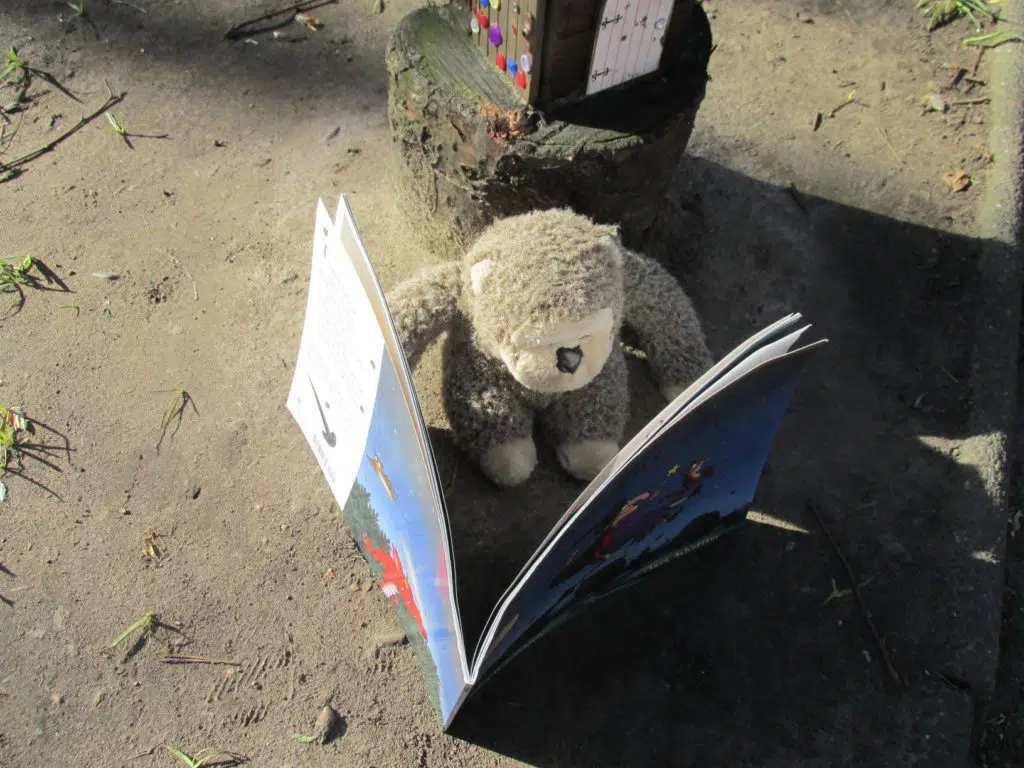
6. Puppet Tells A Story With Props
This is very simple, but one of the best ways of storytelling with puppets. Make up a story about an adventure the puppet has been on.
Bring it to life with a few props – e.g. he could have found the witch’s hat when he escaped from the castle. Or the giant’s ring when he climbed down a beanstalk.
It helps to have just a few interesting objects in some sort of bag or box. It is quite open-ended. Get the children to imagine what has happened, and don’t just tell them. A few objects can go a long way.
Alternatively, if they can’t really think of much, get the puppet to tell a few tales of what has happened with each prop. With storytelling, the more you can model and show them what to do, the quicker they will start copying and doing it themselves.
7. Puppet Characters From A Story
You can find puppet characters that link really well to stories. How many stories feature bears? Suddenly any normal teddy can suddenly become the star of a book.
You often find generic animal characters in many books, and some finger puppets or toys can be brought out at this moment. You can interview a few puppets, talk about what they’re doing or predict what’s about to happen.
Interviews are great and tend to work best if you start adult-led. Just use a microphone or something that looks a bit like a microphone (such as a brush!)
Tapping into children’s interests using things like puppets is one of the most engaging teaching strategies you can try. To find out the 17 best ways of motivating young children, then take a look at this article.
Ask the puppet some questions that link slightly to the story they are involved in. For example, if the puppet is the giant from Jack and the Beanstalk, ask him, ‘What do you like to eat? Where do you live? How do you get there?’ Just make it up. If the children digress a long way from the text, it is not a disaster. It promotes their communication and imagination skills.
8. Sound-Talk Phonics
Puppets are brilliant for teaching a range of phonics skills, and this phonics activity in particular links really well to storytelling.
This is my favorite way of teaching oral blending. Get any sort of puppet like a string puppet or even a toy or teddy will work fine. Then the puppet whispers in your ear. They basically tell a simple story, but one word of each sentence is split up into sound talk.
For example, you might say ‘This is Don Duck. Today he went to a party in the p-a-r-k. Where was the party?’ (The park!) ‘At the party, he ate a c-a-ke. What did he eat?’ (A cake)
Continue like this. It doesn’t have to be the world’s greatest story. Just a way of giving context to segmented words. The more context, the easier the job of blending them becomes.
I would recommend doing this simple activity every single day just for a couple of minutes when you are beginning to teach this skill. It is the best way I have found of giving children confidence quickly. To read many more fantastic phonics games using puppets, then take a look at this article.
Blending becomes something linked to their lives, and they start to understand it not as something abstract, but as something that is connected to them.
9. Puppet Phonics Games
You can also use simple puppets and a few props to teach children a range of skills in phase one phonics. For example, rhyme, blending, and alliteration can be taught really well with puppets in a made-up story scenario.
One of my favorite games is Feed The Monkey. For this all you need is toy monkey (or any puppet), and a few items of food that are quite easy to sound out. Good examples would be a cup, a jug and ham.
The monkey is going on a picnic! He’s hungry and want to eat.
Get the children to try to sound out the objects in sound-talk, e.g. c-u-p, and then put that item in his picnic hamper.
The back—story just brings the game to life, and gets children more engaged with the phonic element.
To find out a whole range of simple phonics games for segmenting, you can read Oral Segmenting Activities – 16 Fantastic Games.
10. Puppet Theater
Puppet theaters often inspire a wealth of communication and talk. It doesn’t have to be that difficult to set one up. A couple of curtains suspended from the ceiling, or a simple wooden frame will really do the job.
Have a selection of puppets for children to explore. Puppet play such as this does need modeling. If you can show how to use puppets in adult-led story-telling, it will get much better results.
Books that have repeated refrains are a good introduction. Get the children to all say the refrain along with the puppet. Hopefully, some of them may transfer this into play.
11. Puppets In Play Areas
Puppets can also be integrated into a range of play situations. Construction is a fantastic one and such a great fun. Building something for a puppet gives your creation context.
They can also create settings for their puppet. The mouse could be living in a dinosaur world for example. Children can construct other parts of the story, such as other characters, or problems.
Puppets in small-world play, role-play, and even in areas such as maths can have significant benefits.
12. ‘And Then’ Story
This is a strategy to use when the children have got reasonably confident at telling stories, and they are at least prepared to have a go.
Sit in a circle, and have a puppet that you are going to pass around the circle. The idea of this game is that when they are holding the puppet each child makes up a bit of the story. They say a sentence or a couple of sentences and then they pass the puppet to the next child. Whenever you start speaking you say ‘And then’.
For example child one might say, ‘And then the princess sneaked through the door into the castle.’
(They pass the puppet)
‘And then she saw a skeleton. She screamed!’
They pass it again.
‘And she ran away etc.
Just continue, passing the puppet and making up a story. Don’t worry if it is totally random and unstructured. It would be strange if it wasn’t.
13. Sharing Stories For Maths
Puppets and sharing go really well together. Sharing objects is probably the simplest introduction to division.
For example, as a little scenario, if you have two puppets and six sweets, how can you share them between the two?
Many children will understand that you must split them so that one puppet gets one, and then the other gets one. Then you continue like this until all the sweets are used up.
They experience this process in their lives, and so understand how to make it fair for the puppets.
This is a very simple adult-led introduction to sharing, but one of the most effective.
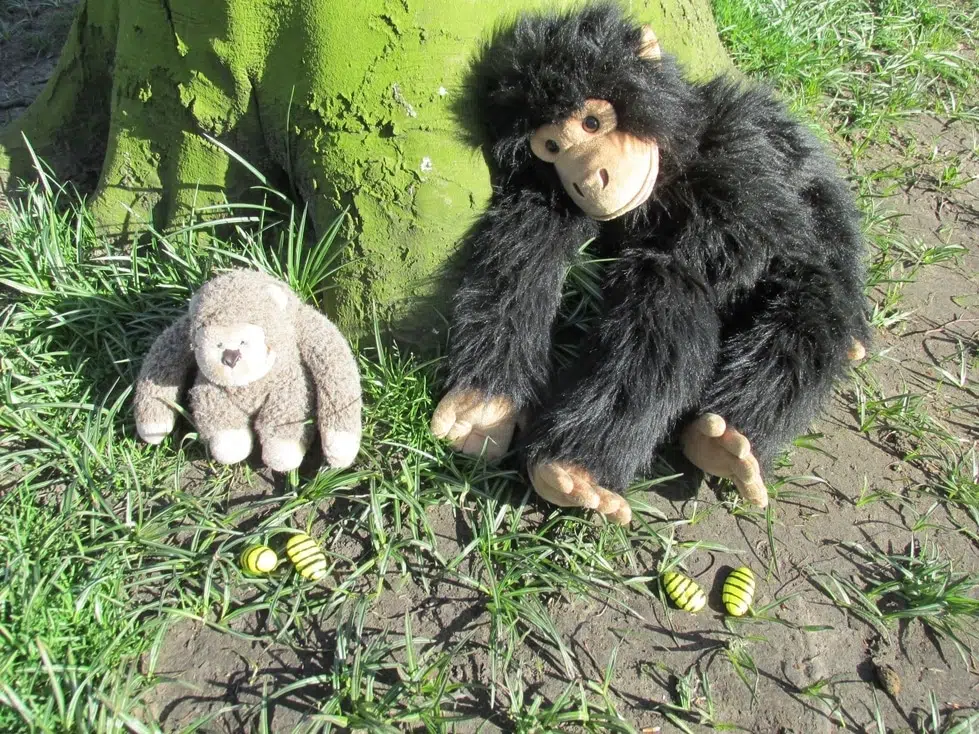
14. Bounce The Puppet On The Parachute!
Poor puppets can be used to be bounced around on the top of a parachute (or a big sheet will do the job as well).
Start with all the children holding the parachute, and put the puppet in the middle of the chute.
Then start a story. The adult can lead the story, or if the children are confident then they can either join in or lead it to.
Just make up a story, and bring it to life with sound effects and associated movements of the parachute.
For example, it might go a bit like: ‘One day Max the Monkey was on a pirate ship. The waves were going up and down. (Make the parachute go up and down). Suddenly a sea serpent thrust his head out of the water and roared (do a roaring sound and shake the chute). He took a bite out of the boat (shake the chute). What might happen next?’
Keep going, animating the story with sound effects, drama, and physical movements.
This kind of activity is great for coordination, teamwork, and also the strength in their hands. Any activity with sound effects is also great for speech and language, and children get great benefits from repeating simple words and phrases together. To find out the greatest 40 parachute games for kids then click here.
Puppets are one of the things that really bring the early years to life. Children have an innate fascination for them and really enjoy interacting with them.
There is no right or wrong in storytelling, which lots of children really appreciate. Puppets can really fire their imagination, and get them talking and telling stories independently.
Related Questions
How can you use puppets to teach maths?
Puppets are fantastic for leading counting. They can help you count in a range of ways. Puppets can miss out a number, and children can fill in the gap. Children can hold puppets and jump along number lines, exploring counting forwards and backwards. To read my favourite 14 math activities to play with puppets go to Using Puppets To Teach Math – Top 14 Activities
How can you use puppets to teach phonics?
Puppets are I think the best way of teaching oral blending through stories that include sound-talk. They are also great for introducing sounds. Puppets can help children begin to read simple three-letter words. You can read more about this in my article Teaching Phonics With Puppets – The Magic Revealed!
Conclusion
Puppets are such a magical tool for generating storytelling in a range of ways. Children enjoy telling stories to puppets. They want to find out what has happened to a puppet if it has been lost, hiding or (even worse) kidnapped.
Story sessions with puppets can be further brought to life with instruments, props and songs. Good luck with bringing storytelling to life with puppets!
